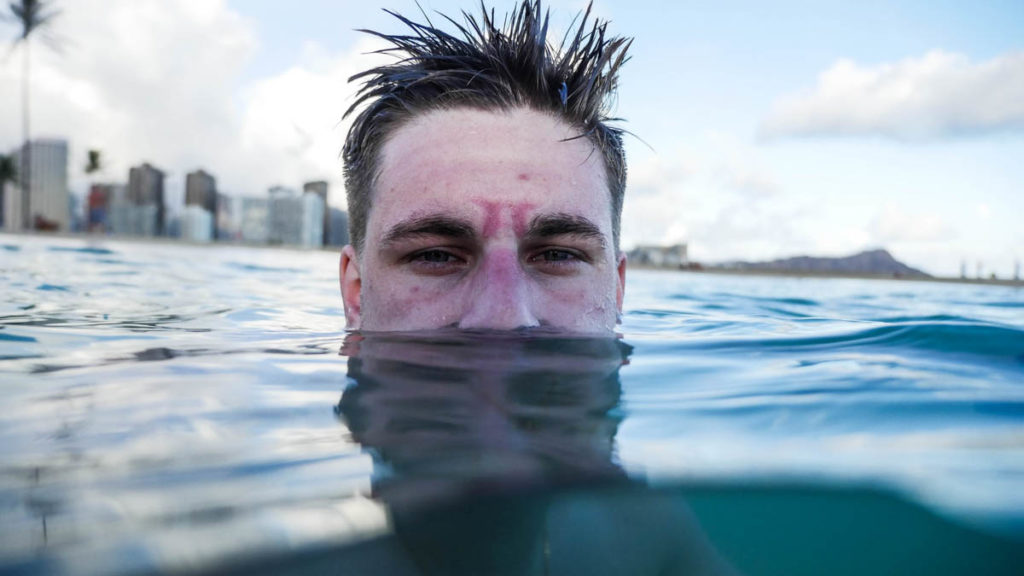Basic Approach and Equipment Selection Criteria
The EPA (US Environmental Protection Agency) and the NOAA (National Oceanic and Atmospheric Administration) together published an important report on diving operations in polluted waters in 1985. This report stated that the best dry suit to be used for contaminated water diving is something “with a smooth skin appearance, with integrated gloves and a hood”.
While the vulcanized rubber suit is certainly an example of smooth skin material, they did not state that it was the only possibility. The report published was very clear because it was the only material that could be decontaminated and the only thing mentioned was that smooth skin materials were easier to clean. The main reason for this recommendation is that it is relatively easy to decontaminate a smooth skin suit. Some tri-laminate drysuits are very smooth and there are also newer polyurethane suits to consider.
Vulcanized rubber drysuit fabrics have been used by public safety divers for many years. There are two reasons for their popularity. One of these is the relative ease of decontamination. The second is their perceived resistance to penetration due to chemical contamination. However,
other options are available today and are often better suited to the diver’s mission and circumstances with the appearance of better decontamination methods and a better understanding of the limitations of all materials in chemically contaminated water. The report also did not mention other equipment worn by divers. BCD, regulator hoses, full face masks, etc.
Even if the divers wear a vulcanized rubber drysuit that has been properly decontaminated, there is a possibility of cross-contamination with BCD. Also, contamination of the full face mask and hoses should be more important as the diver will breathe with this equipment. Until
today, there is no detailed standard established by any public safety agency for diving in contaminated water. Even research contributors in the United States including the NFPA (National Fire Protection Agency) do not have many technical details as discussed below. However, they reflect the difficulties of establishing detailed standards when precise water analysis is not possible, and dive conditions and missions may be constantly changing according to the situation. From this point of view, contamination levels can be analyzed in 4 main categories.
First Category – The Highest Contamination
Extremely contaminated by concentrated chemical or microbiological contamination. Examples may include heavy fuel spills and sewage processes. Divers should wear full diving helmets with surface supplied air and communications, vulcanized rubber dry suits and rings with integrated helmet mating collars and dry gloves. The helmet should be equipped with at least one pair of exhaust valve assembly designs for use in contaminated water. The helmet must be used in free-flow mode. This configuration will facilitate complete encapsulation and decontamination of the diver. A protection level.
Second Category – Middle Contamination
Both chemical and microbiological contamination are expected to increase. Divers can use a positive pressure full face mask in positive pressure mode. A block for emergency gas passage should be used to save gas in the occurrence of primary supply failure. A dry hooded suit and gloves are required for complete encapsulation. B protection level.
Third Category – Light Contamination
No contamination is expected above the baseline that is normal for human habitation. Categories two and three will be the type of contamination that most dive crews and research divers will encounter during normal activities. Divers should wear a positive pressure full face mask to prevent water contact with mucous membranes and mouth (unless water analysis shows an acceptable risk of mouth contact) and should have thermal protection appropriate for diving conditions. Normally, category three can increase recovery in water, the contamination level in the body area to category two. A reserve diver should be prepared in case of an unexpected
change in the situation. C protection level.
Fourth Category – No Contamination
This includes recreational areas such as offshore ocean locations, drinking water reservoirs, swimming and ski areas or situations where water quality is routinely checked, no pollutants are reported, and contaminated sources are not known or expected. While any diving equipment suitable for water temperature is acceptable for diver protection, local authorities can dictate
what divers can wear in the water so you cannot introduce contaminants into the water. Decontamination may be required before entering the water. D protection level.
Diving Operations in Polluted Waters
Some chemicals are so dangerous that no diver should ever consider working around them. These chemicals include the following, but are not limited to: Acetic anhydride, Acrylonitrile, Carbon tetrachloride, Cresol Chlorine, Dichloropropane, Epichlorohydrin, Ethylbenzene, Methyl chloride, Methyl parathion, Perchlorethylene Styrene and Trichlorethylene Xylene. At least in the training, polluted water diving training should be applied and the training should include water scenarios and the following topics:
- Hazard recognition and assessment
- Decision to Go / Discontinue
- Equipment selection
- Dive planning
- Dressing procedures
- Dive procedures
- Emergency procedures
- Post-dive decontamination

The main points to consider are these
Equipment
Special equipment is generally required for dirty water diving operations. Both divers in the water and support personnel on the surface must be properly equipped. Equipment used for polluted water diving is slightly different from standard “out of shelf” scuba or surface-assisted
diving equipment.
Commonly used standard diving equipment have several properties that make diving unacceptable in contaminated water. Neoprene drysuits are not adequately decontaminated. Masks, helmets, numerical “breakable” seals on suits increase the potential for leakage and their reliable dry glove arrangements are few. Also, the exhaust valves in the air regulators allow a few small drops of water to enter during the exhaust cycle. When the demand valve is activated during inhalation, the incoming air stream allows the droplets and a mist that is then inhaled by the diver to enter in.
It is important to keep in mind that accidents occurring while diving in polluted waters may require additional procedures before standard diving accident management begins. While vulcanized rubber dry suits help protect most divers against biological contamination, they do not protect them from all kinds of chemical contamination or radiation.
CAUTION: No type of diving helmet/mask or suit can provide complete protection against exposure to underwater pollutants. It can be moved a long way toward reducing the likelihood of accidents with the combination of the best quality, well-scanned equipment, proper training, safety awareness and common sense. There is no such thing as 100 percent safe contaminated water diving. Just as there are different levels of protection for HAZ-MAT (Hazardous substances and products) situations, there are also different types of diving equipment to choose from based on the
level of danger underwater.

Unfortunately, there is currently no standard for diving equipment that can be selected based on the potential effects/risks of the danger for divers. After evaluating the actual and potential contaminants during the dive planning process, three options are available.
Diving is not an option when unacceptable exposure conditions exist or when there are chemicals in the water that a diver should never be allowed to work on. In this case, other tools (remotely operated tools, surface sampling devices, etc.) should be used to obtain the required data.
For less severe but still dangerous exposures where a diver’s immersion in water is absolutely necessary, total encapsulation (i.e. full coverage paired with a dry suit with dry gloves) is required.
In less polluted environments (ie where contaminants are bound to sediments or waters carry low levels of biological contamination), the full face mask can usually be used with dry clothing and dry gloves. This system provides less protection than a helmet, but much more than a half-mask used with a tank and regulator.
Material Permiability
This parameter measures the rate at which a contaminant penetrates the material of the suit. Although stated to be for hood, drysuit, seams, seals or zipper, actual information ONLY applies to dry fabrics. No information has been published on the permeability of seams, seals or zippers).
TLS (tri-laminate) material can generally outperform better than vulcanized rubber. There is no suitable material in any of the 5 chemical classes of FEMA (Federal Emergency Management (Authority) that provides full protection that reaches the target in 3-hour tests. Any material did not show a result well in hexane, and only neoprene did well in toluene (the
most aggressive hydrocarbon). Naturally, neoprene is also the most difficult material to decontaminate. However, all drysuits share a common weakness in order to the zipper, neck seals, wrist seals, and rubber is made from materials that are least resistant to many chemical contaminants. In addition, all these tests were tested on new drysuits. Ageing, abrasion, cuts or previous exposure to hazards can reduce the performance of the material. Also, there is no way of knowing how the suit will react to multiple contaminants or repeated exposures. Although it is absolutely theoretically possible, we do not know whether the permeability can be increased by pressure. In considering these variables, chemical tests have questionable value. This is especially true when no substance is performing well on all pollutants.
Tensile Strength and Penetration Resistance
Both are very important in situations where high abrasion is expected or where the diver is likely to come into contact with, particularly sharp metal or other sharp edges. In such environments, the ability to decontaminate a suit can be less of an issue than ensuring that the diver has a puncture-resistant barrier.
Additional Criteria
Other criteria that dive crews can use to determine equipment needs include:
A self-wearing drysuit that can fit a wider range of diver is very important. Because it will allow more divers of various sizes to wear less number of common drysuits and can greatly facilitate entering the water in case of emergency rescue.
The fitting of the suit in body is generally ignored. However, a poorly fitting suit can make it difficult for the diver to perform the intended task. Vulcanized rubber drysuits are offered in only a few sizes as a disadvantage and are difficult to customize. This is a more specific problem for female divers.
RESCUE IN WATER WITH HIGH FLOW often requires the use of SCUBA due to its high water flow rate. Drift is also an important issue. Many public divers use more fluid and durable suits such as crushed or compressed neoprene in such situations when major contamination is not suspected. Some diving crews may also choose a light trilaminate drysuits because it is an advantage that it is light and can dry quickly even at very cold temperatures. All these suits have excellent buoyancy abilities which is also an important consideration in high-flow situations. The choice depends on the durability requirements of the team and how close they want to be in contact with the suit
Some other things to consider include:
- Surface suit only: some sets may require cuff castings only
- Boots for stability in hard water conditions
- Knee, elbow and hip reinforcements
- Knife pocket in the set
RESCUE IN ICE can involve both surface and diving works. Most rescue situations are surface works and most rescue operations can be integrated with diving. Tri-laminate or vulcanized rubber fabrics perform better performance in very cold environments as they do not freeze in the air. This type of operation requires extensive specialized training and equipment for divers and surface support personnel.
Article Kindly Submitted by Ömür METE / Scuba Instructor






